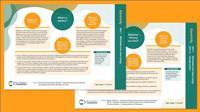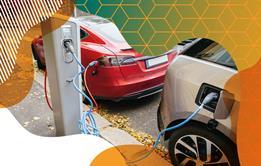Use batteries and electric cars as contexts for teaching about electricity
This resource is also available in Welsh and Irish
Get the Welsh language version.
Get the Irish language version.
How do we store the energy from sustainable sources such as wind and solar power? And how sustainable are batteries really? This topic web contains sustainability context ideas and classroom activity suggestions for teaching electricity to 7–9 year olds. Explore how batteries store energy, or discuss the sustainability credentials of the batteries used in electric cars.
Each web explains the background science, describes how scientists are working in this field, and suggests ways to explore this in the classroom.
How to use this topic web
This resource is part of our Sustainability contexts for primary science teaching collection. The series features a total of 20 topic webs designed to help you link your existing curriculum teaching to sustainability issues.
Find out more about how to use this topic web in your teaching.
-

Download this resource
Get both topic webs on electricity and batteries for 7–9 years, with tips and suggested activities to use in the classroom.
Topic web 1: What’s a battery?
What’s the science?
Batteries are often taken for granted, yet many people don’t fully understand what they are or how they work. Batteries are not a source of electricity but are a store of chemical energy that is transferred into electrical energy – a process called electrochemistry. The demand for batteries that are more powerful, longer lasting and less damaging to the environment is becoming ever more pressing. Even rechargeable batteries have a limited lifespan.
What are scientists doing about it?
Often electricity from solar panels and wind turbines is not produced at times when demand is highest. Scientists continue to research how to store this electricity in efficient batteries until it is required. Rechargeable batteries, in cars and mobiles, are often lithium-ion but ‘rechargeable’ does not equal ‘ever-lasting’ so scientists are developing batteries with prolonged lifespans. They are researching materials for batteries as alternatives to lithium that are even more versatile.
How could you explore this in the classroom?
- Discuss with learners where the electricity comes from to power an appliance. Ask them to name as many electrical devices as possible and then differentiate between those powered from the mains (plugged in) or elsewhere (a battery or solar energy). Link to numeracy by asking them to display this in a Venn diagram.
- To observe how a battery supplies energy in a fun way, use a ‘Circuit Ball’ or ‘Energy Stick’ (available from retailers like school suppliers, eg TTS, Amazon, or eBay) to create ‘human circuits’. When the metal strips on the ball or stick are both touched, current is passed through sweat on fingers to complete the circuit. The battery is found inside the ball/stick.
- Ensure learners know it is unsafe to dismantle a battery. Instead, to consider how a battery stores energy, use a commercially available lemon or potato clock kit to build your own, or watch a video. Batteries depend upon the chemistry going on inside. Compare the brightness of lights powered by lemons and conventional batteries. This may be by observation (real life or videos) or measurement if a voltmeter is available.
Curriculum links
Electricity; numeracy (representing data); literacy (writing instructions); DT; observing and measuring.
Topic web 2: Batteries ‘driving’ our lives?
What’s the science?
Pollutants from petrol and diesel cars are a major contributor to global warming. Battery-powered cars are often presented in the media as a panacea for this problem. However, there are issues with the production and disposal of batteries in terms of environmental impact. The materials used in their manufacture can be rare and their extraction may have a negative environmental impact.
What are scientists doing about it?
Scientists are constantly seeking to improve the efficiency and lifespan of batteries – not only for use in transport, but in other technologies too. Scientists are researching alternatives to traditional battery components as a way of potentially addressing environmental problems. Other scientists are aiming to extend the life of rechargeable batteries so that they need to be replaced less often.
How could you explore this in the classroom?
- Discuss the need to end reliance on vehicles powered by fossil fuels. Do the learners appreciate why this is important? What alternatives are there? They may suggest fully electric cars, hybrids, hydrogen cars or using a bike. Are they aware that the electricity for cars may be produced at fossil-fuelled power plants?
- A ‘team’ of learners could create a presentation about the positives and negatives of using batteries or fossil fuels to power vehicles. The rest of the class could then cast votes on which they think is the sustainable fuel for the future.
- Electric and hybrid cars depend on efficient batteries. Learners can make a simple motor to exemplify how batteries can transfer energy needed for movement.
- Investigate with the learners the difference that is made by using batteries of different voltages. Ask them to predict what will happen.
- Learners can use a world map to identify the major battery-material producing countries. They can colour code according to the material extracted. Have them investigate the carbon impact of transporting raw materials to the place of manufacture.
Curriculum links
Electricity; observing; introducing motors; predicting; geography; literacy (discursive writing).
Try these additional resources
- Try more sustainability topic webs to provide context for key topics in primary science, including habitats, materials and water and the water cycle for 7–9 year olds.
- Explore electricity further with our topic web on electricity for 9–11 year olds.
- Find out more about careers in chemistry such as Zubera’s role as a research fellow trying to find a sustainable way to recycle electric vehicle batteries.
Downloads
Electricity and batteries | 7–9 years
Presentation | PDF, Size 0.11 mb
Additional information
Sources:
School Science/Lemon Battery | Wikibooks
Batteries and electrochemical cells | RSC
Lemon battery breaks Guinness World Record | YouTube
Developing countries pay environmental cost of electric car batteries | UNCTAD
Demand for raw materials for electric car batteries set to rise further | UNCTAD
Sustainability contexts for primary science

Find out how to teach science curriculum topics through engaging sustainability contexts. Our topic webs include suggestions for classroom activities that develop numeracy, literacy and scientific skills.
- 1
- 2
- 3
- 4
 Currently
reading
Currently
reading
Electricity and batteries | 7–9 years
- 6
- 7
- 8
- 9
- 10
- 11



































No comments yet